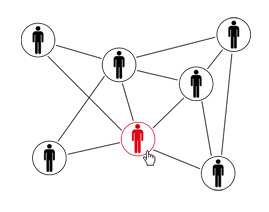High Potentials vs High Performers
Mistaking a high-performing employee for a high-potential employee can be costly. If organisations are not able to clearly distinguish between performance and potential, it will be challenged to really identify high- potential talent.
An example is the high performing sales person promoted to sales manager as the organisation considers he/she has potential. What often happens is the sales person really struggles in the transition and adapting to the new managers role, often failing and ultimately leaving the organisation. A high performer doesn't guarantee they will turn into a high potential. A common occurrence that happens often.
A leader who understands the difference between performance and potential will be better able to engage and retain talent who have aptitude in one or both. This leads us to the question of how to identify and develop high potentials and high performers. This article outlines the strategies any leader can apply to identify, assess and develop high potentials and high performers.
Identifying High Performers and High Potentials
High performers stand out in most organizations. They consistently exceed their targets, tackle difficult projects because they have a track record of getting the job done and they are great at their job and take pride in what they achieve, but may not have the potential (or the desire) to succeed in a higher-level role or to tackle more advanced work. They tend to seek more challenge in their area of expertise.
High potentials have demonstrated initial aptitude for their technical skills and are seen as having future potential. In other words, they can possibly do more for the organization longer term.
High potentials are hard to identify, for a couple of reasons. First, high performance is easy to observe that it drowns out the less obvious attributes and behaviours that characterize high potentials such as seek greater authority, assume responsibility for others and enhanced status. It’s important that they see themselves as moving up the ladder. You also need to tell them they are high potential, involve them in decision making, set clear goals and match organisation needs to their aspirations plus train them across departments.
In addition, not too many organizations clearly articulate the attributes and competencies they value in high potential employees–which means that leaders don’t know precisely what to look for to assess potential. As a result, most leaders focus exclusively on performance.
That is not wrong as organisations need to value and reward performance. However, if the goal is to build a more robust and sustainable talent pipeline, then performance can’t be the only point of entry. Its important to develop the ideal profile of the attributes for key roles and let leaders know so they can clearly identify and further develop high potentials.
Each category requires a different development strategy. With a clearer picture of who falls where, leaders can make more informed decisions in how to effectively develop them.
“If performance is the only criteria employees are evaluated on, then
high performers will be the only ones getting promoted and high
potential’s will be leaving”
Assessing Performance vs. Potential
An established standard of the attributes and competencies of model employees is also an essential part of objective assessment. Although, there’s a distinct difference between potential and performance, experts agree that employees should be assessed on competency in both.
Figure 1 provides a framework for identifying the typical traits of performance vs potential.
| High Performance | Regularly exceeds expectations Lacks skills for success at higher level |
Sets standard of excellence in role Model leadership candidate |
| Low Performance | Little-to-no aptitude Weak, unsatisfactory performance |
Above-average aptitude Inconsistent performance |
| Low Potential | High Potential |
High Per/Low Per employees may be ideal candidates for soft skills development, or for roles that require more technical skills.
Development Strategies
In an ideal world, every employee in the organization would be a high performer with high potential–but that’s obviously not realistic. The appropriate question is how to move employees toward the upper-right quadrant, or at least to the high-performance tier.
It’s not always possible, nor always the desired goal (you might want to keep your high performers right where they are, for instance). There’s no one-size-fits-all strategy, but
Figure 2 provides a general development framework of strategies to consider.
| High Performance | Keep them where they are, or promote Constant encouragement Challenging assignments Soft skill development |
Keep them where they are, or promote Provide autonomy |
| Low Performance | Performance plan Termination |
Pair with a High Performer New role better aligned with skills Training Test with more responsibilities |
| Low Potential | High Potential |
Recognition is key for High Per/Low Po employees. They need constant encouragement and challenging assignments. Rather than promoting them to roles they don’t want (or aren’t ready for), give them the independence and ownership of projects and/or teams.
Alternately, while High Po/Low Per employees may be hungry for more high-impact work, they need seasoning. On the job training is a great way to accomplish this, especially when pairing them with high performers who can serve as mentors.
As they develop a stronger understanding of the organization and their role in it, test the capabilities of high potentials with more projects to manage, new hires to train, give them projects to manage, and offer cross-training opportunities.
An Effective Talent Pipeline is Managed by the Leaders in the Organisation
The line leader plays a big role in building the talent pipeline. It’s increasingly important that they are empowered to do so successfully. While most will have some natural ability in identifying, assessing, and engaging performers and potentials, few will be adept at all three.
If you want to improve your line leaders ability to retain your high-potential and high-performing employees, assessing their competencies and attributes, and setting them up for success, then investing in line leaders development to be able to do just that will be time well spent.
If you liked this article, please let me have your comments/views and also share with friends and colleagues.
You May Also Like

The CMO of People
Many organizations are not getting the best out of their HR function. Ask a CEO, “What is your...

The Challenges of Hiring Future Ready Leaders and Russian Doll Theory of Hiring
One of the biggest challenges most companies face today is hiring transformational leadership talent...

Why Do Most Innovation Programmes Fail?
What do companies do when a new boss says “Innovation has to be part of our DNA”? Here ...

The Greatest Resource any Organization has is the Creativeness of People
For too many years people have been treated as expense items instead of highly valuable resources. T...

How To Quit A Job You Love
It is not easy to quit a job you love. Even with a new dream job in-hand, cutting the cord that conn...

Take on Mistakes
Yes, we do say mistakes teach you a lot and you shouldn’t be afraid of making mistakes. But we...

Five Stages Of Organization Evolution And Key Characteristics And Concerns At Each Stage
Organizations almost always progress through five more-or-less well-defined evolutionary growth stag...

Managing in Multi-Cultural Environment
As several companies expands the business overseas, it is crucial to understand how to run the busin...

Crossing Corporate Cultures Creativity In Organizations Across Industries
Every market has its own unique business practices. People working in different business sectors dev...

Four pillars of Yoga for holistic health
Every human is unique; therefore it is necessary for each of us to find out for ourselves how we can...

Brave to Lead Like a Girl
All of us are dealt a unique deck of cards. Our aim is to identify our strengths and play those card...

How do you Extend Influence to Others and Change Lives?
You Change Lives When You Empower Others! (Extending Influence #1) When you empower others you chan...

How Important is Vision in a Successful Life?!
Understanding Vision (How Important is Vision #1) How do you communicate and give vision to ...

How do you Extend Influence to Others and Change Lives?
You Change Lives When You Empower Others! (Extending Influence #1) When you empower others y...

Is 7% good enough?
A topic discussed at the recent World Economic Forum was the reluctance of male executives to mentor...

Learning & Development as Part of a (Digital) Transformation Strategy
The global workforce is constantly evolving to support a knowledge based, digital economy. Due to th...

The Future of Work – Digital Nomads and the Gig Economy
It is estimated that within a short couple of years, a large portion of the workforce (estimated to ...

Political Correctness towards Civility To be, or not to be, politically correct...
We can incidentally praise or criticize others depending on how we say it, the word choice or expres...

Let's not confuse loyalty with longevity
Let's not confuse loyalty with longevity It is interesting that the issue of loyalty in the wor...

The Attitude of Gratitude - Replying does not mean Answering
The Attitude of Gratitude - Replying does not mean Answering In the ever increasingly connected di...

(Work-Life) Balance or Harmony (! / ?)
(Work-Life) Balance or Harmony (! / ?) Welcome to the world of Work-Life Harmony, beyond Work-Life...

Making Board Meetings More Agile
Making Board Meetings More Agile Given my belief that the world we live in today has changed irreve...

It's Good To Fail
It's Good To Fail I want to share with you something different from a normal convocation speech...

Four Lifehacks To Be More Productive Now
Four Lifehacks To Be More Productive Now Here are four daily life-hacks to help you to be more pr...

A leader sets an example, a leader doesn’t just order things, he does it so that others can do it
A leader sets an example, a leader doesn’t just order things, he does it so that others can do...

How would you end Executive Loneliness?
How would you end Executive Loneliness? What is the hardest part about being a leader? Altho...

Leadership Soft Skills Required for Business and Personal Success
Leadership Soft Skills Required for Business and Personal Success We often get asked, “What s...

New-G Leaders: Remember the Cow
New-G Leaders: Remember the Cow "Cow Don't Drink Water, Cannot Push Cow Head Down"&nbs...

Google your self
What are your key leadership attributes? The beliefs and behaviours that make you unique and success...

Culture is not enough … Get the right culture
A few years ago in Europe I asked a group of business leaders if they had the right culture. S...

How Leaders Can Create a Culture of Agile Collaboration to Win in a VUCA World
China growth-deceleration, the normalisation of monetary policies on the USA, tepid economies in Eur...

Is LinkedIn Improving Itself Out of Business?
I still remember the day I joined LinkedIn. A friend of mine called in frustration and asked w...

Life is the Name. Transformation is the Game.
Over the past half a century, I come to realize life is about having gratitude and resilience. We ne...

How to handle negativity and negative colleagues at work
In arithmetic's, negative into negative equals positive. But that’s just in arithmetic'...

ADAPT or PERISH: It is time for HR professionals to decide and create a new function or move out of the way!
Artificial intelligence in recruitment and performance management giving employees their key deliver...

Leadership Confidence in Times of Uncertainty
How do you successfully lead an organization in uncertain challenging times? Unparalleled st...

Insights for Making Working at Home Work!
How can business and HR leaders manage challenges and find opportunities in the new realities of wor...

The Real You Is Not Really You…
The Real You Is Not Really You… We tend to see and act with our surrounding based o...

3 Powerful Lessons To Make A Successful Career Out Of Your Passion
It Feels Like a Dream As I went on stage today to receive the Asia's Most Talented Coaching Lea...

How to Recover Your Direction - a case study during COVID19
What really happened 5 days ago I set myself a new challenge. Coronavirus had fundamentally changed...

Career Tips, Please
Last week, I was tagged by the fab Tim McDonald in a LinkedIn post asking to share some pointers for...

Impact of AI on the workforce Pre and Post the Pandemic
With the sudden advent of COVID-19 - a global crisis of unprecedented scale, organisations now are c...

Career Kickstart
The first job you land could be the most important decision you make in your career. I have seen th...

Peter Principle - Are you a victim or Perpetrator?
The Peter Principle – Who do YOU Blame? In my junior years of business, many times clients an...

4 Best Practices CEOs and Public Speakers Can Learn from Athletes
What struggles do CEOs and public speakers have in common with athletes? For one, there’s the...

Who do you want to be in COVID-19?
Whilst reviewing friend’s pages on Facebook, previous colleagues, mentors and my business netw...

TRUST – The core enabler that influences and inspires your team
These are certainly extraordinary times for leaders. What do employees need from leaders? In...

On Mentoring
I attended a conference some years back. At one point when the speaker asked, “How many of us...

Men of Faith
Mankind is meant to create, both with their body and mind because that creates balance within. It ke...

What Being on TED Taught Me About Comfort Zones
“In order to grow, you’ll need to step outside your comfort zone.” We’ve al...

3 Tips for Setting and Achieving Goals
Last week I wrote about when setting goals for 2021 we should Go Big or Go Home because it...

Never ask employees what would make them happy at work. Do this instead...
Most managers have realized by now that happy workplaces are more productive, more creative, attract...

How to Choose the Right HRMS Product/Platform
The size of the business has become irreverent when it comes to the technology embracing, to remain ...

So, #IWD is done - where to next?
This week saw a record number of events to mark International Women's Day by organisations - bot...

The trauma of being “made redundant”
At work, there’s nothing quite as horrifying as the experience of being “made redundant&...

My Hopes and Dreams for Malaysia in 2021
Let’s face it – 2020 was not what we envisioned it to be. Since the start of last year, ...

What could post COVID mean for organizations?
This article was co-authored by Dave Ulrich. During this time of limited human interaction, we...

The foolproof way to get a new team to start collaborating, quicker – even in hybrid work environments!
The >#wfh environment does not give us enough organic opportunities to break the ice with ...

Why Do I Keep Hiring the Wrong People?
According to Hudson Singapore, 37% of employers are expecting to increase headcount in the first hal...

Being a Business Woman was Never My Plan
I never wanted my own business. It was never in my plans. Sure, I have an MBA. And, yes I have a fam...

The great resignation or attraction! Is this about work-life balance....or work life purpose?
In recent weeks, there have been many studies by McKinsey, Microsoft and others published that indic...

Tune in to your self to stay tuned to work
I began writing an article on LinkedIn in early 2018 with the same title and saved it as a draft. Th...

Self-Leadership - The Critical Success Factor
What is the critical factor for any organization, large or small, to achieve success? Is it a clear...

Appreciation at Workplace
One of my early memories of my first job after graduating is that working life was terrible. Why did...

The 6 'HABITS' of highly successful “Assistants”
No matter what your title, it is most definitely how you think, what you say and your behaviour that...

AI Thinking I We are Heading Towards Self-Awareness Machine (AGI)
AI Thinking I We are Heading Towards Self-Awareness Machine (AGI) Neuralink It is a neurotechnolog...

Are Capitalism and Democracy Compatible?
Are Capitalism and Democracy Compatible? America prides itself on being able to run two great syste...

The Neurodiverse An Untapped Pool of Exceptional Talent
Our understanding of the brain and how it works so magnificently, has increased exponentially over t...

Everyone's a Great Writer Now! So Why Does Reading Feel So Empty?
Everyone's a Great Writer Now! So Why Does Reading Feel So Empty? AI can make anyone sound like...








John Eddy
Executive & Career Coach, Australia
John Eddy is a passionate Executive & Career Coach who works with leaders across the Asian market. John is dedicated in helping leaders grow and develop personally & professionally. His many years working in Senior Human Resources & Talent Development roles across Asia.